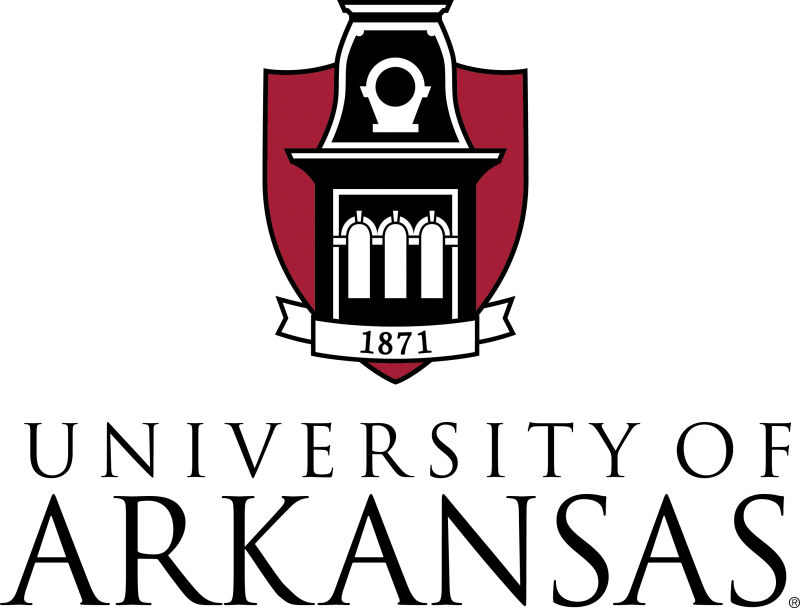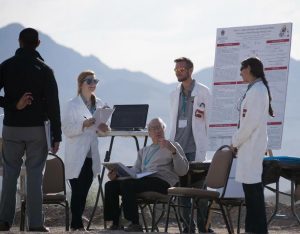Three teams of University of Arkansas students recently won awards at the International Environmental Design Contest at New Mexico State University. The competition, known as the WERC competition, had three set categories – haul truck tires used for mining, municipal wastewater cleanup, and an open task. Competing against 20 other teams, each team provided a written report, a safety summary and flow sheet, a fifteen minute oral presentation, a bench scale operation and a poster presentation.
The U of A team competing in the haul time category won first place in their category. The team was comprised of Joseph Dancy, Juan Sagarnaga, Omkar Bhave, Marina Lee,* Jessica Lizarazu,* and Luis Villarreal. Although they are all chemical engineering majors, their design was more mechanical in nature.
The team’s task was to figure out how to best recycle the tires used in mine machinery.
“The tires used in mines are huge and expensive, and there are few productive ways to recycle the material,” said team coordinator Joseph Dancy. “Some mines throw the tires into old mines and bury them, but this is a temporary solution. We wanted a new idea that would prove beneficial to all parties.”
Team member Juan Sagarnaga’s idea of tire recycling was inspired by his time interning at a mining company in Bolivia. Mining companies use cylindrical shells called ball mills to grind and blend materials. “In Bolivia, I learned about the interior of ball mills. We saw that the liner was made of thick, tough rubber,” said Sagarnaga. “So, I thought, ‘These tires are similar to haul tire rubber so how can we convert them to go into ball mill walls?’”
From there, the team reached out to environmental experts and Bridgestone representatives at Cripple Creek and Victor Gold Mining Company and Newmont Mining to determine the logistics of haul tire recycling and the achievability of the idea. With their support and that of James Barron and University of Arkansas master scientific research technician, George Fordyce, the team was able to make a bench scale replica of a ball mill with haul tire lining.
The team competing in the wastewater category won second place in their category, and they received the Freeport McMoran Innovation Award. Chemical engineering students Kaylee Smith,** Zach Bare,* Dustin Resz,* Mikayla Parton, Holly Wilder and Indran Kamalanathan** designed a process to treat municipal wastewater for beneficial use.
“To do this, we visited towns in New Mexico to determine a good location to base our design off of.” said Kaylee Smith, team coordinator. “We determined chemicals that would be problematic and designed a bench scale that would purify caffeine and chlorpyrifos (an insecticide) from the water.”
To accomplish this, the team ozonated the water samples and then used ultraviolet light and a granulated activated carbon filter to remove the chemicals.
“By utilizing our time and resources as wisely as possible, we were able to bring all of our ideas together and create a great, operable bench scale,” said Smith.
The team competing in the open task won second place and the Energy Efficiency and Pollution Prevention Award. The team, comprised of chemical engineering students Teni Butler,** Andrew Casey,** Lindsey Mayo,* Collin Michael,* Jonathon Schumaker, and Elisabeth Westcott,* designed a project focused on efficiency and particulate matter emission testing of wood-burning heating units.
“Wood burning is a prevalent source of primary residential heating and it’s growing,” said Teni Butler, the team’s coordinator. “If you look at census data, you can see between 2000 and 2010, a 34 percent growth in wood burning for primary heating for homes. One third of the population uses wood for secondary heating as well. Unfortunately, about eleven percent of all cancer causing particulates are directly related to that wood combustion.”
During recent years, the EPA has set standards and regulations on wood-burning unit manufacturers, but the funding of research has put many of the companies out of business. There has been a 90 percent decrease in manufacturers since the 1980s.
“Our goal was to develop a low cost, reliable method to determine particulate matter emission and the efficiency of a wood burning heating unit,” said Butler.
In order to calculate this, the students analyzed the exhaust gas from the stove, which they split into separate streams called sampling trains. “We designed and constructed two different sampling trains – one for particulate emission and the other to determine efficiency,” Butler explained.
The team used the same filters that the EPA uses on their particulate matter train, but removed intermediate steps while still achieving consistent, accurate results. Their efficiency train was similar to the train used currently in the industry, but simplified and more cost efficient.
Each team had exceptional things to say about Roy Penney, professor Emeritus and the current director of WERC competitors at the University. They also praised Mick Ackerson, the future director, and the individuals who contributed to the success of teams.
“A great help to our Water Team design process was Tammy Lutz-Rechtin,” said Smith. “She was essential in setting up analytical tests and troubleshooting of our bench scale. Professor Shannon Servoss graciously allowed us to utilize the equipment in her lab.”
For students who are interested in the opportunity, the competitors highly recommended the experience.
“You receive your project and you have the opportunity to work with your design from start to finish,” said Bhave of the Haul Tire Team. “It’s all about practical experience. You learn to work with all types of people in the industry of your future career. It’s all about ownership and determination.”
*Honors College student
**Honors College Fellow



